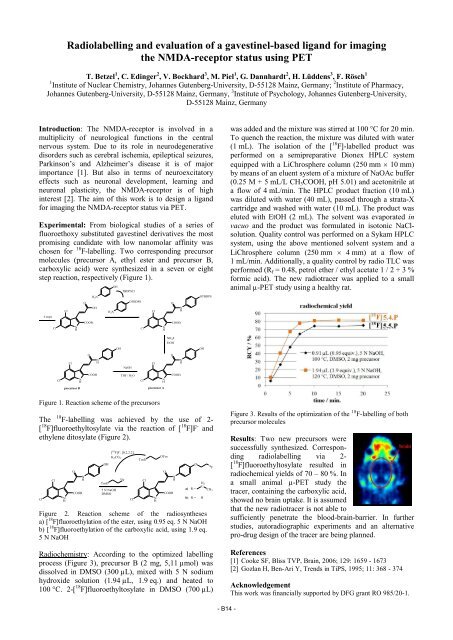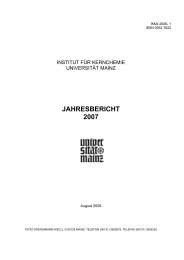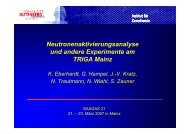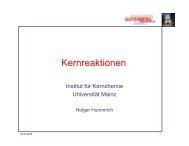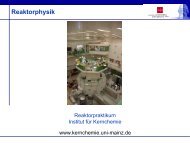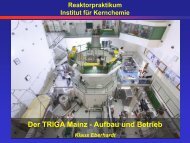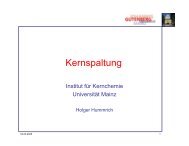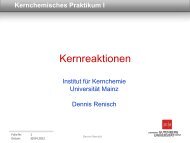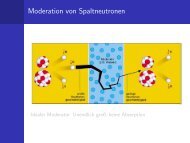institut für kernchemie universität mainz jahresbericht 2009
institut für kernchemie universität mainz jahresbericht 2009
institut für kernchemie universität mainz jahresbericht 2009
Create successful ePaper yourself
Turn your PDF publications into a flip-book with our unique Google optimized e-Paper software.
Radiolabelling and evaluation of a gavestinel-based ligand for imaging<br />
the NMDA-receptor status using PET<br />
T. Betzel 1 , C. Edinger 2 , V. Bockhard 3 , M. Piel 1 , G. Dannhardt 2 , H. Lüddens 3 , F. Rösch 1<br />
1 Institute of Nuclear Chemistry, Johannes Gutenberg-University, D-55128 Mainz, Germany; 2 Institute of Pharmacy,<br />
Johannes Gutenberg-University, D-55128 Mainz, Germany, 3 Institute of Psychology, Johannes Gutenberg-University,<br />
D-55128 Mainz, Germany<br />
Introduction: The NMDA-receptor is involved in a<br />
multiplicity of neurological functions in the central<br />
nervous system. Due to its role in neurodegenerative<br />
disorders such as cerebral ischemia, epileptical seizures,<br />
Parkinson’s and Alzheimer’s disease it is of major<br />
importance [1]. But also in terms of neuroexcitatory<br />
effects such as neuronal development, learning and<br />
neuronal plasticity, the NMDA-receptor is of high<br />
interest [2]. The aim of this work is to design a ligand<br />
for imaging the NMDA-receptor status via PET.<br />
Experimental: From biological studies of a series of<br />
fluoroethoxy substituted gavestinel derivatives the most<br />
promising candidate with low nanomolar affinity was<br />
chosen for 18 F-labelling. Two corresponding precursor<br />
molecules (precursor A, ethyl ester and precursor B,<br />
carboxylic acid) were synthesized in a seven or eight<br />
step reaction, respectively (Figure 1).<br />
6 steps<br />
Cl<br />
Cl<br />
Cl<br />
Cl<br />
N<br />
H<br />
precursor B<br />
N<br />
H<br />
O<br />
COOEt<br />
O<br />
H 2N<br />
OH<br />
COOH<br />
N<br />
H<br />
H 2N<br />
OH<br />
OH<br />
TBDPSCl<br />
NaOH<br />
THF / H 2O<br />
OTBDPS<br />
Cl<br />
Cl<br />
Cl<br />
Cl<br />
N<br />
H<br />
N<br />
H<br />
precursor A<br />
Figure 1. Reaction scheme of the precursors<br />
O<br />
NH 4F<br />
EtOH<br />
COOEt<br />
O<br />
COOEt<br />
N<br />
H<br />
N<br />
H<br />
OTBDPS<br />
The 18 F-labelling was achieved by the use of 2-<br />
[ 18 F]fluoroethyltosylate via the reaction of [ 18 F]F - and<br />
ethylene ditosylate (Figure 2).<br />
Cl<br />
Cl<br />
N<br />
H<br />
O<br />
COOR<br />
N<br />
H<br />
OH<br />
TosO<br />
5 N NaOH<br />
DMSO<br />
[ 18 F]F - , [K2.2.2],<br />
K 2CO3<br />
18 F<br />
Cl<br />
TosO<br />
Cl<br />
N<br />
H<br />
OTos<br />
O<br />
COOR<br />
N<br />
H<br />
a) R =<br />
O<br />
OH<br />
b) R = H<br />
18 F<br />
H 2<br />
C CH3<br />
Figure 2. Reaction scheme of the radiosyntheses<br />
a) [ 18 F]fluoroethylation of the ester, using 0.95 eq. 5 N NaOH<br />
b) [ 18 F]fluoroethylation of the carboxylic acid, using 1.9 eq.<br />
5 N NaOH<br />
Radiochemistry: According to the optimized labelling<br />
process (Figure 3), precursor B (2 mg, 5,11 µmol) was<br />
dissolved in DMSO (300 µL), mixed with 5 N sodium<br />
hydroxide solution (1.94 µL, 1.9 eq.) and heated to<br />
100 °C. 2-[ 18 F]fluoroethyltosylate in DMSO (700 µL)<br />
- B14 -<br />
was added and the mixture was stirred at 100 °C for 20 min.<br />
To quench the reaction, the mixture was diluted with water<br />
(1 mL). The isolation of the [ 18 F]-labelled product was<br />
performed on a semipreparative Dionex HPLC system<br />
equipped with a LiChrosphere column (250 mm � 10 mm)<br />
by means of an eluent system of a mixture of NaOAc buffer<br />
(0.25 M + 5 mL/L CH3COOH, pH 5.01) and acetonitrile at<br />
a flow of 4 mL/min. The HPLC product fraction (10 mL)<br />
was diluted with water (40 mL), passed through a strata-X<br />
cartridge and washed with water (10 mL). The product was<br />
eluted with EtOH (2 mL). The solvent was evaporated in<br />
vacuo and the product was formulated in isotonic NaClsolution.<br />
Quality control was performed on a Sykam HPLC<br />
system, using the above mentioned solvent system and a<br />
LiChrosphere column (250 mm � 4 mm) at a flow of<br />
1 mL/min. Additionally, a quality control by radio TLC was<br />
performed (Rf = 0.48, petrol ether / ethyl acetate 1 / 2 + 3 %<br />
formic acid). The new radiotracer was applied to a small<br />
animal µ-PET study using a healthy rat.<br />
Figure 3. Results of the optimization of the 18 F-labelling of both<br />
precursor molecules<br />
Results: Two new precursors were<br />
successfully synthesized. Corresponding<br />
radiolabelling via 2-<br />
[ 18 F]fluoroethyltosylate resulted in<br />
radiochemical yields of 70 – 80 %. In<br />
a small animal µ-PET study the<br />
tracer, containing the carboxylic acid,<br />
showed no brain uptake. It is assumed<br />
that the new radiotracer is not able to<br />
sufficiently penetrate the blood-brain-barrier. In further<br />
studies, autoradiographic experiments and an alternative<br />
pro-drug design of the tracer are being planned.<br />
References<br />
[1] Cooke SF, Bliss TVP, Brain, 2006; 129: 1659 - 1673<br />
[2] Gozlan H, Ben-Ari Y, Trends in TiPS, 1995; 11: 368 - 374<br />
Acknowledgement<br />
This work was financially supported by DFG grant RO 985/20-1.


